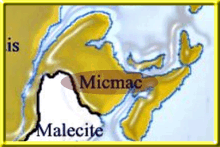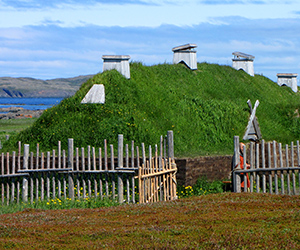CANADA HISTORY
North Peigan

The North Peigan, also known as the Piikani Nation, are a First Nations people originally from the foothills of the Rocky Mountains in what is now Alberta, Canada. Before contact with Europeans, the North Peigan people lived a semi-nomadic lifestyle as hunters, fishers, and gatherers. They were part of the larger Blackfoot Confederacy, a group of First Nations people that included the North Peigan, Siksika, and Kainai, who shared similar languages, cultural practices, and spiritual beliefs.
North Peigan society was organized into clans, each with its own unique traditions and customs. The society was matrilineal, meaning that descent and inheritance were traced through the maternal line, and the clans were led by the eldest women. Hunting, fishing, and trading were important aspects of North Peigan culture, and the people were known for their horsemanship and use of the horse in warfare and hunting.
Religion was an important aspect of North Peigan life, and the people had a rich spiritual tradition that included a belief in the power of spirits and the importance of performing ceremonies to maintain balance and harmony in the world. They also held a strong belief in the afterlife, with a spiritual world that was seen as being parallel to the physical world.
Overall, the North Peigan people lived a subsistence lifestyle based on their relationship with the land and their spiritual beliefs, and their culture was deeply connected to the natural world around them. However, contact with Europeans and the imposition of European-style governance, religion, and ways of life drastically altered the North Peigan's way of life and continue to impact their culture and society to this day.
The first recorded contact between the North Peigan and Europeans took place in the late 18th century, although it is likely that there were earlier, undocumented encounters. In 1793, British explorer and fur trader Alexander Mackenzie passed through the area in his quest to find a trade route to the Pacific Ocean. In the decades that followed, European fur traders, including the Hudson's Bay Company and the North West Company, established trading posts in the region and began to interact with the North Peigan and other First Nations people.
However, this contact had far-reaching and devastating impacts on North Peigan culture, economy, and way of life. The introduction of new diseases, such as smallpox, by the Europeans decimated the population, and the fur trade brought new economic and social pressures. The signing of Treaty 7 in 1877 marked the beginning of the reserve system and government control over First Nations peoples, including the North Peigan, and led to the loss of their traditional territories and way of life.
the North Peigan people were involved in trading with the Europeans, including the fur trade. Fur was a valuable commodity in Europe and was in high demand, and the North Peigan and other First Nations people in the region had a rich supply of beaver, mink, and other animals that were sought after by the Europeans.
The North Peigan people and other First Nations peoples played a significant role in the fur trade, acting as middlemen between the Europeans and other indigenous groups further to the west and north. They would trade furs and other goods, such as horses and buffalo hides, with the Europeans in exchange for metal tools, weapons, and textiles.
However, the fur trade also had negative impacts on the North Peigan way of life. The increased competition for resources and the introduction of new technologies and weapons disrupted traditional economic patterns and led to social and political changes. The fur trade also played a role in the spread of diseases, such as smallpox, which had devastating effects on the North Peigan and other First Nations populations.
Despite these negative impacts, the North Peigan and other First Nations peoples continued to participate in the fur trade for many years, adapting and adjusting their trade strategies and relationships in response to changing circumstances and opportunities.
Within this confederacy, the North Peigan people were organized into clans, each with its own unique traditions and customs. Each clan was led by the eldest women, who held the responsibility for making decisions about the clan's welfare and for representing the clan in negotiations and alliances with other clans and nations.
There were also influential leaders, known as "headmen," who were chosen for their skills in hunting, war, and diplomacy, and who played a role in negotiating treaties and representing their people in inter-tribal relations. These headmen held a great deal of prestige and were highly respected members of their communities, but their power was not absolute and was balanced by the decision-making power of the women's councils and the collective opinions of the community.
In general, the North Peigan political structure was characterized by consensus and cooperation, with decisions being made through a combination of community discussions and negotiations between leaders. This system allowed for a great deal of flexibility and adaptation in response to changing circumstances and opportunities, but it also meant that there was not a single, centralized political authority that controlled the entire North Peigan nation.
The North Peigan people, like many indigenous cultures, had a long history of inter-tribal conflict with other First Nations peoples. This was due in part to the competition for resources, such as hunting grounds and water, and to the need to defend their territories from raiders.
The North Peigan people were part of the larger Blackfoot Confederacy, which was an alliance of three First Nations peoples – the North Peigan, Siksika, and Kainai – that was formed in response to threats from other indigenous groups, such as the Cree, Assiniboine, and Shoshone. The confederacy allowed the Blackfoot peoples to pool their resources and to present a united front in conflicts with other tribes.
However, the Blackfoot peoples were also involved in conflicts with one another, as each nation competed for resources and sought to assert its dominance. These conflicts could be resolved through diplomatic means, such as negotiations and alliances, or through military action, such as raids and battles.
It is important to note that the nature of these conflicts changed significantly after contact with Europeans, as the arrival of fur traders and settlers brought new sources of competition and tension. The introduction of guns and other weapons by the Europeans also changed the balance of power, making inter-tribal conflict more deadly and destructive.
In general, inter-tribal conflict was a complex and dynamic aspect of North Peigan and First Nations life, shaped by a combination of economic, political, and cultural factors. Today, the North Peigan people, like many indigenous communities, are working to promote peace and cooperation with their neighboring First Nations peoples and to heal the wounds of the past.
The history of the North Peigan people is complex and spans many centuries, and includes a rich and diverse set of events and experiences. Some of the key dates and events in the history of the North Peigan include:
Pre-Contact Era (pre-1700s): The North Peigan people have a long and rich history in the region, dating back thousands of years. They lived in a complex and decentralized society, based on hunting, gathering, and trading, and were part of the larger Blackfoot Confederacy.
First Contact with Europeans (1700s-1800s): The first recorded contact between the North Peigan people and Europeans occurred in the 1700s, with the arrival of fur traders and other explorers in the region. Over time, the fur trade and other forms of trade and exchange became increasingly important to the North Peigan economy, leading to the growth of new settlements and communities in the region.
Treaty 7 (1877): Treaty 7 was signed between the Crown and several First Nations peoples, including the North Peigan, Siksika, and Kainai, on September 22, 1877. The treaty established the reserve system in southern Alberta and created a framework for the relationship between the First Nations peoples and the Canadian government.
Indian Act (1876): The Indian Act was enacted by the Canadian government in 1876, and is a key piece of legislation that governs the rights and responsibilities of First Nations peoples in Canada. The Indian Act established the reserves, created the Indian Department to administer First Nations affairs, and introduced a number of policies and regulations that had far-reaching impacts on the lives and communities of the North Peigan and other First Nations peoples.
Residential Schools (1880s-1996): Residential schools were government-run institutions that aimed to assimilate First Nations children into Canadian society. Many First Nations children, including North Peigan children, were taken from their families and sent to these schools, where they were subjected to physical, emotional, and sexual abuse. The residential school system had a profound and lasting impact on the North Peigan people and other First Nations communities.
Self-Government (1980s-present): In the 1980s and 1990s, First Nations peoples across Canada, including the North Peigan, began to assert their right to self-determination and to take greater control over their own affairs. This led to the growth of First Nations governments, the negotiation of modern treaties, and the development of new forms of governance and administration. Today, the Piikani Nation, which is the modern-day name for the North Peigan people, is a self-governing First Nations community, with its own elected council and government.

Cite Article : www.canadahistory.com/sections/documents




